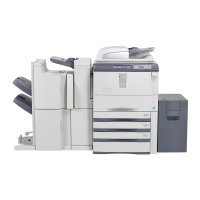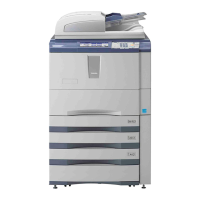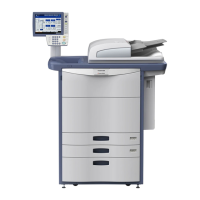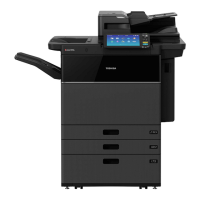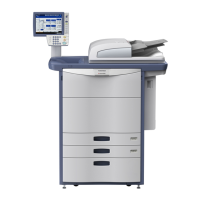
Do you have a question about the Toshiba e-STUDIO 507 and is the answer not in the manual?
| Print Speed (Mono/Black/A4) | 50 ppm |
|---|---|
| Copy Resolution | 600 x 600 dpi |
| Fax Modem Speed | 33.6 Kbps |
| Duplex Printing | Yes |
| Functions | Copier, Printer, Scanner |
| Print Resolution | 1200 x 1200 dpi |
| Scan Resolution | 600 dpi |
| Fax Transmission Speed | 3 seconds per page |
| Network Connectivity | Ethernet |
| Operating System Compatibility | Windows, Mac, Linux |
| Monthly Duty Cycle | 150, 000 pages |
| Type | Laser |
Details the functions and information displayed in the BASIC menu for copier operations.
Information on acceptable copy paper types and how to place paper correctly.
Step-by-step guide on how to load paper into the machine's paper drawers.
Procedure for registering paper sizes to the equipment for correct detection.
Instructions for setting paper thickness and attributes for special paper types.
Guide on how to load paper into the optional large capacity feeder.
Guidance on acceptable originals and how to place them on the glass or RADF.
Instructions for placing originals on the flatbed scanner glass.
Specific instructions for placing book-type originals for copying.
How to use the Reversing Automatic Document Feeder for scanning originals.
Covers the basic steps and procedures for making copies.
Outlines the fundamental steps to perform a standard copying job.
Instructions on how to pause, stop, and restart a copying job.
Procedure for adding new originals while a copying job is in progress.
How to temporarily interrupt a copy job to perform another task.
Function to print a single copy for checking settings before a large batch.
How to choose the output tray for copied documents.
Instructions for using the bypass tray for feeding paper.
Guide for copying standard size paper using the bypass tray.
Procedure for copying non-standard paper sizes via the bypass tray.
Specific steps for copying documents onto envelopes.
Instructions for copying paper with custom dimensions using the bypass tray.
Overview of default settings and how to confirm current functions.
Covers automatic and manual paper selection methods.
How the machine automatically selects paper based on original size.
Steps for manually selecting paper size for specific original types.
Guidance on copying sets of originals with different sizes.
Options for optimizing image quality based on original content (Text/Photo).
How to adjust the darkness or lightness of the copied image.
Methods for changing the reproduction ratio of copied images.
Automatic selection of reproduction ratio based on paper size.
Manual specification of original and copy paper sizes for ratio selection.
How to set the zoom or reproduction ratio using controls.
Overview of available finishing options like sorting and stapling.
Details on various finishing modes and compatible optional devices.
Function to sort or group copies by page order or set.
Copies exit alternately in different directions for each set.
Automatically staples sets of copies at a chosen position.
Finishing modes for booklet creation, folding, and stapling.
Function to punch holes in copied pages using an optional unit.
Instructions for copying on both sides of the paper.
Procedure for creating single-sided copies from originals.
Steps to create double-sided copies from originals.
Specific method for duplex copying of book-type originals.
Function to store copied data to a share folder.
Configuration steps for network share folders for storing data.
How to access the various editing functions via the EDIT menu.
Adjusts image position to create margins for binding.
Steps to create margins on the copy paper for binding.
Specific method for creating binding margins for book-type originals.
Removes dark shaded areas from the edges of copied images.
Whitens the center shadow area when copying book-type originals.
Copies two pages side-by-side onto one sheet.
Shrinks multiple originals onto a single sheet.
Copies originals in booklet format for magazine-style binding.
Overview of various image manipulation functions.
Selectively copies or masks areas of an original.
Functions to flip an image horizontally or reverse its colors.
Adjusts reproduction ratio independently for horizontal and vertical directions.
Adds special paper as front or back cover sheets.
Inserts copied or blank sheets at specified page numbers.
Adds the current date and time to copied documents.
Adds sequential page numbers to copied documents.
Combines multiple jobs with different settings into a single operation.
Controls the orientation of copied pages for correct output.
Adjusts page orientation for book or tablet style copying.
Switches between continuous and single feed modes for the RADF.
Removes blank pages from scanned originals before copying.
Removes shadow-like dark areas outside the copied image.
How to access the IMAGE menu for image adjustment functions.
Overview of image adjustment features.
Adjusts the density of the original's background.
Enhances or softens the outline of the image.
Introduction to creating and using templates for frequent settings.
How to access the template menu for registration or recall.
Information on the default templates available for immediate use.
Procedures for saving custom settings as templates.
Steps to register templates for universal access.
Guide to creating personal or departmental template groups.
How to save templates into a specific private group.
Process of loading saved template settings.
How to modify existing template or group data.
Modifying settings within a private template group.
Editing the settings of a specific saved template.
Instructions for removing unwanted template groups or templates.
Procedure to remove private template groups.
Steps to delete individual templates.
View active, waiting, and completed copy jobs.
How to check the status of jobs currently being processed or queued.
Procedure to remove unwanted jobs from the queue.
How to temporarily halt a job in the queue.
Steps to restart a job that was previously paused.
How to change the order of jobs in the waiting queue.
Information on suspended jobs and how to recover them.
View records of past copying jobs.
Check paper status, size, and type in each drawer.
View the estimated level of toner in the cartridges.
Table showing copy speeds based on paper size, feeder, and paper type.
Matrix detailing which copy functions can be used together.
Part one of the matrix showing function compatibility.
Part two of the matrix detailing function compatibility.



